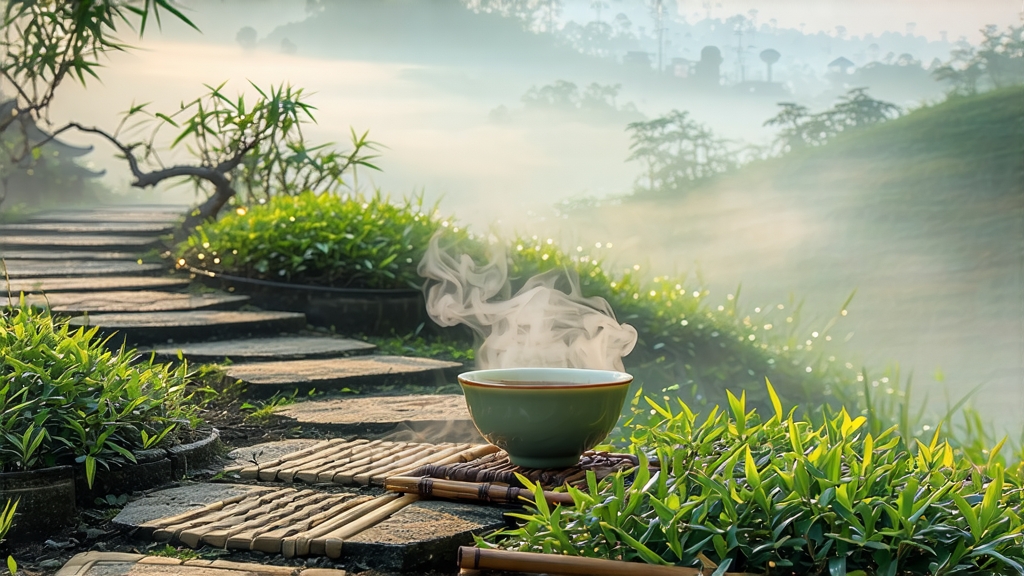
High above the bustle of Chengdu’s plains, where the Sichuan basin collides with the first ridges of the Tibetan Plateau, lies the mist-veiled massif of Mount Meng. For twelve centuries its name has been whispered in the same breath as the most coveted tribute teas of the Middle Kingdom, yet beyond China’s borders it remains almost a legend. Meng Ding Huang Ya—literally “Yellow Bud from the Summit of Meng”—is the noble representative of Sichuan’s yellow tea tradition, a style that sits stylistically and historically between green and dark teas. While green tea is prized for its brisk, grassy immediacy and dark tea for its earthy patience, yellow tea offers a third path: the freshness of spring captured, then mellowed through a secretive “sealed yellowing” that turns leaf proteins into chestnut-sweet amino treasures. To understand Meng Ding Huang Ya is to witness time being gently stretched, a micro-fermentation so subtle that even seasoned tea masters call it “the whispered transformation.”
Historical whispers
The first written record appears in 724 CE, when Tang dynasty chronicler Meng Shen noted that monks at the summit temple presented “a tea of pale gold, picked before the Qingming festival, that calms the dragon within.” By the Song era the buds were pressed into tiny cakes, stamped with the imperial dragon, and couriered down the Min River to Kaifeng’s palace. When the Ming emperor abolished compressed tribute teas in 1391, Mount Meng’s gardeners adapted, keeping only the youngest buds and inventing the slow yellowing process to differentiate their offering from the flood of green teas now freighted along the same imperial roads. The Qing court later fixed the annual quota at 360 liang (13.5 kg), enough for one ceremonial sip each morning of the emperor’s year. Revolution, war and market neglect pushed Meng Ding Huang Ya to the edge of extinction by the 1980s; only a single grove of 300 bushes survived inside the temple walls. A state-led restoration project in 1986 re-grafted those ancients onto 64 hectares of terraces, preserving the original dao xing (knife-shape) cultivar whose tiny, downy buds contain almost twice the theanine of modern clonal teas.
Micro-terroir in the sky
Mount Meng’s classic garden sits between 1,300 m and 1,450 m, a sweet spot where annual rainfall tops 2,000 mm yet morning fog blocks intense UV. The soil is a crumbly purple sandstone rich in selenium and eroded granite; its excellent drainage forces roots to dive three metres, mining minerals that translate into a signature “stone fruit” note. Temperature swings of 15 °C between day and night slow growth so dramatically that the spring budding window lasts barely ten days, concentrating aromatic volatiles. Local proverb says “three days early is treasure, three days late is grass,” a warning that even a 72-hour delay turns the tender bud into a coarse leaf unfit for yellowing.
Pluck code: 100% single bud
Unlike many yellow teas that allow one leaf and a bud, Meng Ding Huang Ya insists on the “arrow pluck”—only the unopened bud sheared at the node. Experienced pickers work from 5 a.m. to 9 a.m., before sunlight raises leaf temperature and starts enzymatic oxidation. The daily harvest is placed in bamboo baskets lined with wild banana leaves to maintain 90% humidity, preventing the grassy bruise notes that can survive the yellowing stage.
Craft: the four silences
Village elders describe the making as “four silences,” steps so gentle that conversation is discouraged lest breath disturb the leaves.
-
Silence of killing green (sha qing)
160 °C wok, 4 minutes, 50 g per toss. The goal is not full de-enzyming like green tea; roughly 15% polyphenol oxidase must survive for later transformation. -
Silence of wrapping (men huang)
The still-warm buds are immediately piled 3 cm thick inside linen bags and placed in a 32 °C, 75% RH chamber for 48 hours. This “sealed yellowing” is the style’s signature: chlorophyll slowly degrades to pheophytin, catechins dimerise, and a honey-coloured pigment forms. Every 12 hours the pile is gently turned without being